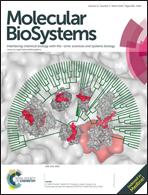Deducing the functional characteristics of the human selenoprotein SELK from the structural properties of its intrinsically disordered C-terminal domain†
Abstract
The intrinsically disordered proteins (IDPs) cannot be described by a single structural representation but, due to their high structural fluctuation, through conformational ensembles. Certainly, molecular dynamics (MD) simulations represent a useful tool to study their different conformations capturing the conformational distribution. Our group is focusing on the structural characterization of proteins belonging to the seleno-proteome due to their involvement in cancer. They present disordered domains central for their biological function, and, in particular, SELK is a single-pass transmembrane protein that resides in the endoplasmic reticulum membrane (ER) with a C-terminal domain exposed to the cytoplasm that is known to interact with different components of the endoplasmic reticulum associated to the protein degradation (ERAD) pathway. This protein is found to be up-expressed in hepatocellular carcinoma and in other cancers. In this work we performed a detailed analysis of the C-terminal domain sequence of SELK and discovered that it is characterized by many prolines, and four negatively and eleven positively charged residues, which are crucial for its biological activity. This region can be considered as a weak polyelectrolyte and, specifically, a polycation, with high disordered propensity and different phosphorylation sites dislocated along the sequence. Then, we modeled its three-dimensional structure by performing MD simulations in water at neutral pH to analyze the structural stability as well as to identify the presence of HUB residues that play a key structural role as evidenced by the residue–residue interaction network analysis. Through this approach, we demonstrate that the C-terminal domain of SELK (i) presents a poor content of regular secondary structure elements, (ii) is dynamically stabilized by a network of intra-molecular H-bonds and H-bonds with water molecules, (iii) is highly fluctuating and, therefore, can be described only through a conformational ensemble, where we evidenced a distribution of equilibrium conformers which continuously inter-change their conformations. Finally to verify the specific role played by the negative charges, we also performed MD simulations at acidic pH. Overall, all the obtained results evidenced that SELK has the dynamic structural features to be defined as a HUB protein able to interact with multiple members. Therefore, considering the possible role that this protein can have in cancer development and progression, it can represent a target for drug design studies.


 Please wait while we load your content...
Please wait while we load your content...